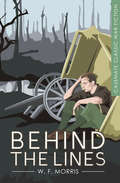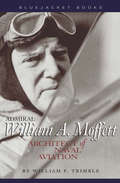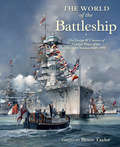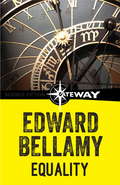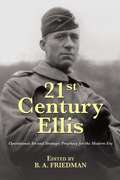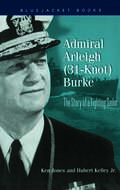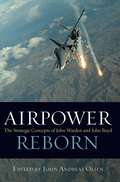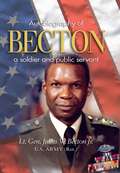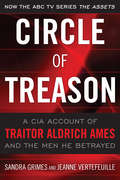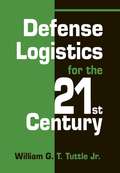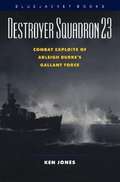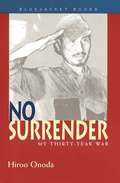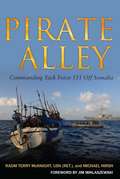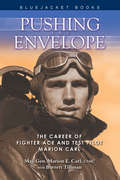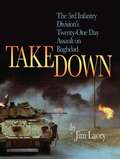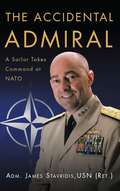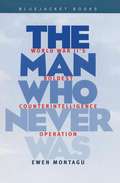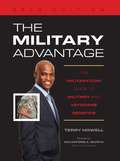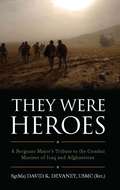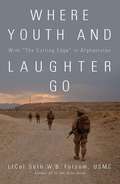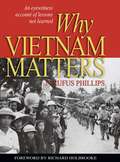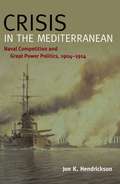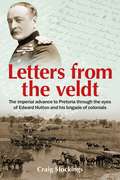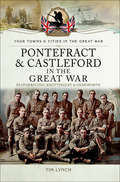- Table View
- List View
Behind the Lines: A Novel (Casemate Classic War Fiction #6)
by W. F. MorrisAfter killing a fellow officer, a British World War I fighter joins the ranks of deserters and outlaws in a suspenseful novel from the author of Bretherton.Behind the Lines follows army man Peter Rawley, who accidentally kills an overbearing, taunting fellow officer and, terrified that he will not receive a fair hearing amid the chaos of the trenches, flees the battlefield. Now a fugitive, Rawley must join forces with other deserters, criminals, and lost soldiers in a hand-to-mouth existence, trying to survive in the no-man&’s-land between opposing armies. He will encounter both adventure and disaster, including capture by the Germans and the threat of a firing squad—and will need to call upon his own bravery and the support of the woman he loves to survive. A thriller from the author of Bretherton: Khaki or Field-Grey?—which was praised by the Sunday Times as &“a mystery as exciting as a good detective story and an extraordinarily vivid account of trench-warfare&”—this is a meditation on the issues of identity and allegiance, as well as the role of chance. Behind the Lines is a classic of WWI fiction and an exciting read that brings the drama of the Great War to life.
Admiral William A. Moffett
by William F. TrimbleNaval aviation historian William F. Trimble provides a clear and detailed portrait of the man who took on the challenge of forming an aeronautical bureau within the U.S. Navy in 1921 and then nurtured the early development of naval aviation. Describing Admiral William A. Moffett as one of the first high-ranking naval officers to appreciate the importance of the airplane and the effect it would have on the fleet, the author contends that the admiral's strong background as a surface officer gave him a credibility and trust with his superiors that others could not match. The author attributes Moffett's desire to keep aviation as part of the fleet, along with his diplomacy, tenacity, and political and military savvy, to the success of the infant air arm during its formative years. In striking contrast to the tactics of Army General Billy Mitchell, Moffett's handling of the loyalty issue and other politically sensitive topics saved the Navy's air arm, according to Trimble. The book is equally candid about the admiral's shortcomings, including his heavy-handed support for airships, a technological dead end that squandered millions and led to Moffett's death in 1933 when he went down with the airship Akron during a storm.
The World of the Battleship: The Design & Careers of Capital Ships of the World's Navies, 1880–1990
by Bruce TaylorThis new volume is intended to present a global vision of the development of the world's battleships. In a collection of chapters by international, the design, building, and career of a significant battleship from each of the world's navies is explored that illuminates not just the ships but also the communities of officers and individuals that served in them and, more broadly, the societies and nations that built them. Each chapter explains the origins of a ship, her importance as a national symbol, and her place in the fleet. This is a highly original and significant book on the great capital ships of the world.
Equality
by Edward BellamyThe sequel to Bellamy's Looking Backward where a young man falls asleep in 1887 and wakes in a utopian year 2000, where all social ills are solved. This novel continues the thread of his utopian vision.Equality begins when Julian West returns to the year 2000 to continue his education. The book describes an ideal society in that year.
21st Century Ellis
by Edited by B. A. FriedmanFor years, the Marine Corps has touted the prescience of Lieutenant Colonel "Pete” Ellis, USMC, who predicted in 1921 that the United States would fight Japan and how the Pacific Theater would be won. Now, for the first time, those predictions and other works by the "amphibious prophet” are available in print. Included is two works by Ellis on naval and amphibious operations, including Advanced Base Operations in Micronesia, the study of tactics and operations in the Pacific Ocean that the United States Navy and Marine Corps would use to win the war against Imperial Japan. Ellis describes the form and functions of a modern Marine Corps designed to win its Nation’s battles. Ellis’ ideas about how the Marine Corps should fight are still in use throughout the world today. Ellis’ ideas on amphibious operations are well known, but his ideas on counterinsurgency and conventional war have been overshadowed and forgotten. Ellis wrote two articles based on his warfighting experiences in the Philippines and as part of the American Expeditionary Force in Europe during World War I. These articles, last published in the early 1920’s, are both republished in this book and show Ellis as a prescient thinker who was ahead of his time. Ellis identifies concepts that the U. S. military struggles with even today, and that other thinkers would not identify for decades after Ellis’ death. Also included are six essays by the editor, introducing the ideas of Pete Ellis and putting them in a modern context. As the United States turns its focus to the Pacific, Ellis’ ideas can inform policymakers on the dynamics of strategy and warfare in the vast reaches of the Pacific Ocean. Edited by Captain B. A. Friedman, USMC, 21st Century Ellis reveals the strategic insights of Pete Ellis for then and now.
Admiral Arleigh (31-Knot) Burke
by Ken Jones Hubert Kelly Jr.Burke's World War II heroics and unprecedented three terms as chief of naval operations are recounted in this stirring biography.
Airpower Reborn
by Edited by John Andreas OlsenAirpower Reborn offers a conceptual approach to warfare that emphasizes airpower’s unique capability to achieve strategic effects. Six world-leading theorists argue that a viable strategy must transcend the purely military sphere, view the adversary as a multi-dimensional system, and pursue systemic paralysis and strategic effects rather than military destruction or attrition. The book is divided into three parts. The first section presents a historical perspective on airpower theory and airpower strategy, tracing their evolution from the 1920s to the 1980s. The second section contains in-depth examinations of the strategic concepts that John R. Boyd and John A. Warden developed in the 1980s and 1990s, with an emphasis on their contemporary relevance. The final section provides further context on modern airpower theory and strategy. Theory, in this setting, serves as the basic paradigm, strategy represents its generic, mechanisms-centered application, and plans of campaign constitute the specific steps for any given situation. In short, the authors look beyond the land-centric, battlefield-oriented paradigm that has continued to dominate military theories and strategies long after airpower offered new options. The book acknowledges the essential role of advanced technology in improving airpower capabilities, but emphasizes that air services must cultivate and harness the intellectual acumen of airmen and encourage officers and men to think conceptually and strategically about the application of aerospace power. Modern airpower can offer political decision-makers more and better options--provided the underlying strategy coherently links the application of airpower directly to the end-state objectives rather than limiting it to "the battle. ” The book recommends that all countries should consider establishing a dynamic and vibrant environment for mastering aerospace history, theory, strategy, and doctrine; a milieu for cultivating broader knowledge of and insight into airpower; and a setting in which airpower experts have the opportunity to communicate their narrative to politicians, the media, and fellow officers, and to interact to mutual benefit with experts from all sectors of governance. This effort should emphasize the potentially unique contribution of airpower to political objectives and joint operations, and in turn connect to operational headquarters that do operational planning. Mastering such strategic thought lies at the heart of the military profession, but it requires in-depth knowledge and understanding of theory, strategy, and airpower, and transcends traditional metrics.
Becton
by Julius Becton Jr.This autobiography, published in cooperation with the Association of the United States Army (AUSA), highlights Lt. Gen. Becton's remarkable career and reveals the influences that contributed to his success. Becton's autobiography reflects on his youth in the suburban Philadelphia area, his parental and family influences, and his almost forty years of service in the U.S. Army and in subsequent civilian appointments. His devotion to leadership, education, service, race, and his spiritual upbringing are all central themes in the book.After finishing high school, Becton entered a segregated Army at age eighteen and over nearly forty years rose to the rank of lieutenant general. Two years after enlisting in the Army Air Corps Enlisted Reserve, he was commissioned a second lieutenant of infantry and subsequently fought with distinction in the Korean War. Integrated into the Regular Army in 1951, he went on to earn undergraduate and graduate degrees in mathematics and economics and held combat commands in the 101st Airborne Division in Vietnam. He commanded the legendary 1st Cavalry Division in 1975-76. Promoted to lieutenant general in 1978, he served as commanding general of the U.S. VII Corps in Germany and deputy commander of Training and Doctrine Command and the Army Inspector of Training before retiring in 1983.Following retirement he entered fields of international disaster assistance, emergency management, and education. Becton joined the Reagan administration in 1984 as Director of the Office of Foreign Disaster Assistance for the Agency for International Development. From 1985 to 1989 he was Director of the Federal Emergency Management Agency. Over the next six years, he was the COO of American Coastal Industries and president of Prairie View A&M University. His final civilian post was as CEO/Superintendent of public schools in the District of Columbia.Becton was listed several times by Ebony magazine as 'One of the 100 Most Influential Blacks in America.' In 2007 he was selected to receive the George Catlett Marshall Medal, the highest award presented by the Association of the U.S. Army (AUSA) for being a 'soldier, combat commander, administrator, educator, public servant, government leader, and role model.'
Circle of Treason
by Sandra V. Grimes Jeanne VertefeuilleCircle of Treason details the authors' personal involvement in the hunt for and eventual identification of a Soviet mole in the CIA during the 1980s and 1990s. The search for the presumed traitor was necessitated by the loss of almost all of the CIA's large stable of Soviet intelligence officers working for the United States against their homeland. Aldrich Ames, a long-time acquaintance and co-worker of the authors in the Soviet-East European Division and Counterintelligence Center of CIA, turned out to be that mole. In April 1985 Ames walked in to the Soviet Embassy in Washington, D. C. and volunteered to the KGB, working for the Soviet Union for nine years until his arrest by the FBI in February 1994.Ames was arguably one of the most destructive traitors in American history, and is most well-known for providing information which led to the death of at least 11 Soviet intelligence officers who spied for the West. The authors participated in the majority of these cases and the book provides detailed accounts of the operational contact with the agents as well as other similar important cases with which the authors also had personal involvement. The stories of the brave men who were executed or imprisoned by the Soviet Union include GRU General Dmitriy Fedorovich Polyakov, KGB Colonel Leonid Georgiyevich Poleshchuk, KGB Colonel Vladimir Mikhaylovich Piguzov, GRU technical officer Nikolay Chernov, GRU Lieutenant Colonel Boris Nikolayevich Yuzhin, KGB scientific and technical officer Vladimir Ippolitovich Vetrov, GRU Colonel Vladimir Mikhaylovich Vasilyev, GRU officer Gennadiy Aleksandrovich Smetanin, KGB illegals support officer Gennadiy Grigoryevich Varenik, KGB scientific and technical officer Valeriy Fedorovich Martynov, KGB political intelligence officer Sergey Mikhaylovich Motorin, KGB officer Sergey Vorontsov, and Soviet scientist Adolf Grigoryevich Tolkachev. Other operations include KGB technical officer Viktor Ivanovich Sheymov, GRU Colonel Sergey Ivanovich Bokhan, and KGB Colonel Aleksey Isidorovich Kulak. Of particular note in the preceding list of agents compromised by Aldrich Ames is GRU General Dmitriy Fedorovich Polyakov, the highest-ranking spy ever run by the U.S. government against the Soviet Union during the Cold War. Described as the "Crown Jewel", he provided the U.S. with a treasure trove of information during his 20-plus year history of cooperation.The book also covers the aftermath of Aldrich Ames arrest: the Congressional wrath on CIA for not identifying him sooner; FBI/CIA debriefings of Ames following his plea bargain; a retrospective of Ames the person and Ames the spy; and a comparison of Ames and FBI special agent and Soviet spy Robert Hanssen, arrested in February 2001 and sentenced to life in prison for spying for the Soviet Union against the U.S. for over 20 years. Although not personally involved in the Hanssen investigation, the two authors were peripherally involved in what became, after many false starts the Hanssen case.
Defense Logistics for the 21st Century
by William Tuttle Jr.The last comprehensive study of defense logistics was published in 1959. In the ensuing forty-five years a revolutionary change in information technology and defense strategy has swept the field and mandated a new understanding of the objectives and principles of military logistics. The author, renowned defense logistics expert General William Tuttle, covers all aspects of the subject including force projection, force sustainment, and minimizing the logistics "footprint" in battle spaces. Within these objectives, he includes five principles that are employed to assess the effectiveness of the process and identifies their shortfalls and remedies. He also illuminates the major influences of culture and politics on defense logistics and proposes ways to minimize their adverse impact on combat readiness. Written for defense logistics leaders - those currently coping with the challenges and those logistics aspiring to lead - and for everyone involved in the complexities of planning and strategy, this up-to-date volume is sure to become a hallmark in the field.
Destroyer Squadron 23
by Ken JonesCalled one of the most inspiring stories to come out of World War II when first published in 1959, this epic account of Arleigh Burke's legendary Destroyer Squadron 23 is much more than a story of ships and their tactical deployment. It is a story of men in action--some four thousand of them--and how they lived and fought as a magnificent combat team.Ken Jones not only records their heroic deeds but helps explain what prompted those deeds, including the leadership qualities that fired the men into action. In doing so he brings to life the outfit's fighting spirit--that mysterious combination of qualities inspired by great leaders that wins battles--and the man who led them. Commodore Arleigh Burke was the right man at the right place at the right time; his leadership fused the squadron into a superb combat organization.This book offers a vivid account of the fighting in the South Pacific during one of the most crucial periods of the war. In authentic, minute-by-minute detail drawn from once-secret documents, Jones describes the battles of Tassafaronga, Savo Island, Empress Augusta Bay, and Cape St. George. But the focus throughout is on the men as they meet the test of battle with a common bravery as staunch as any in the Navy's annals. No squadron in any navy is said to have won more battle honors in less time than the Fighting Twenty-third.
No Surrender
by Hiroo OnodaIn the spring of 1974, Second Lieutenant Hiroo Onoda of the Japanese army made world headlines when he emerged from the Philippine jungle after a thirty-year ordeal. Hunted in turn by American troops, the Philippine police, hostile islanders, and successive Japanese search parties, Onoda had skillfully outmaneuvered all his pursuers, convinced that World War II was still being fought and that one day his fellow soldiers would return victorious. This account of those years is an epic tale of the will to survive that offers a rare glimpse of man's invincible spirit, resourcefulness, and ingenuity. A hero to his people, Onoda wrote down his experiences soon after his return to civilization. This book was translated into English the following year and has enjoyed an approving audience ever since.
Pirate Alley
by Michael Hirsh Terry McknightRear Admiral Terry McKnight, USN (Ret.) served as Commander, Counter-Piracy Task Force-Gulf of Aden. He wrote the first draft of the Navy's handbook on fighting piracy while serving as the initial commander of Combined Task Force 151, an international effort to deploy naval vessels from several nations in a manner designed to prevent piracy in the Gulf of Aden and farther out into the Indian Ocean. McKnight personally commanded operations that disrupted several hijackings in progress, and resulted in the capture of sixteen Somali pirates. That's when he ran head-on into the bizarre U.S. policy of catch-and-release, and realized that there's a lot more to fighting piracy than just catching some skinny youngsters armed with AK-47s and RPGs.After his tour in the waters off the Horn of Africa and the Arabian Peninsula, he retired from the Navy and began seriously researching the subject. As a result, he and his co-author, journalist Michael Hirsh, have put together a very readable book that serves as a comprehensive introductory course on the subject. Pirate Alley includes a behind-the-scenes look at the SEAL Team 6 takedown of the pirates who had kidnapped Captain Richard Phillips of the Maersk Alabama. It also reveals what a young Ph.D. candidate from Duke University found during three months on the ground in Somali pirate villages.Pirate Alley explores every aspect of Somali piracy, from how the pirates operate to how the actions of a relative handful of youthful criminals and their bosses have impacted the world economy. The book examines various answers to the question "How do you solve a problem like Somalia?" It explores the debate over the recently adopted practice of putting armed guards aboard merchant ships, and focuses on the best management practices that are changing the ways that ships are outfitted for travel through what's known as the High Risk Area. Readers will learn that the consequence of protecting high quality targets such as container ships and crude oil carriers may be that pirates turn to crime on land, such as the kidnapping of foreigners.The work also focuses on the worldwide economic impact of piracy, noting that despite claims that piracy is costing as much as $13 billion a year, one of the largest commercial shipping companies argues that over-reaching national and international shipping regulations have a significantly greater negative effect on the world's economy than does piracy.In the book's conclusion, McKnight contends that, in the interest of justice, nations need to beef up their ability to prosecute and imprison captured pirates. And that the United States has no choice but to continue to hew to a policy that was first stated in Article 1 of the U.S. Constitution: The Congress shall have Power...to define and punish Piracies and Felonies committed on the high Seas, and Offences against the Law of Nations.
Pushing the Envelope
by Barrett Tillman Gen. Marion CarlFirst published in 1994, this stirring autobiography of a fighter and test pilot takes readers full throttle through Carl's imposing list of "firsts." Beginning with his World War II career, he gained such commendations as first Marine Corps ace, among the first Marines ever to fly a helicopter, and first Marine to land aboard an aircraft carrier. His combat duty included the momentous battles at Midway and Guadalcanal. Not one to rest on his laurels, however, he participated in photoreconnaissance operations over Red China in 1955 and flew missions in Vietnam. In peacetime he gamed fame for "pushing the envelope" as a test pilot, adding the world's altitude and peace records to his wartime feats and becoming the first U.S. military aviator to wear a full pressure suit. Such achievements also led to Carl's being the first living Marine admitted to the Naval Aviation Hall of Honor, as well as the first Marine to be named to the Navy Carrier Aviation Test Pilots Hall of Honor. This very readable memoir is as forthright and compelling as the man it chronicles.
Takedown
by James G. LaceyOver time the impression has grown that the 2003 invasion of Iraq met with little resistance and that, with few exceptions, the Iraqi army simply melted away. As this book clearly shows, nothing could be further from the truth. In its drive to capture Baghdad, the U.S. Army's 3rd Infantry Division was in nearly constant combat for twenty-one days. While Americans were watching Saddam's statue being torn down on TV, a brigade of the 3rd ID was on the verge of being overrun by Iraqi Republican Guard units trying to escape north. Told to hold two bridges in his sector, a brigade commander had to blow up one of them because he did not have the combat power to hold it. The company commander holding the other bridge was so hard pressed that he called on the artillery to fire their final protective fires a command made only when a unit is in mortal danger and one that had not been given since Vietnam. Every one of the division's armored vehicles was hit by rockets some taking more than a dozen hits and the fighting was so fierce at times that entire battalions ran out of ammunition. Nevertheless, when the fighting was finally over, the 3rd ID had destroyed two Iraqi Regular Army divisions and three divisions of the much vaunted Republican Guard.Takedown tells the little-known story of what happened to the 3rd ID during its struggle to win Baghdad, a campaign that some call one of the most vicious in American military history. To offer this firsthand account, Jim Lacey, a former Time magazine reporter embedded with the 1st Brigade of the 101st Airborne Division, draws on extensive interviews that he conducted with the American soldiers involved as well as access to personal papers and war memoirs. This story is also enriched through his extensive use of interview transcripts of senior Iraqi army officers along with their personal written recollections. From the Kuwaiti border to the streets of Baghdad, these dramatic eyewitness descriptions of what went on give readers an accurate look at the brutal engagements in which the division fought for its life.In making use of such a wealth of primary source material, Lacey has succeeded in writing a fast paced narrative of the conflict, backed up by verifiable facts, that shows how modern wars are really fought.
The Accidental Admiral
by James StavridisDespite demonstrated prowess in the handling of ships and sailors, five years after receiving his commission, Jim Stavridis was planning on getting out of the Navy and going to law school. His assignments officer, a young lieutenant commander by the name of Mike Mullen (who would go on to become Chairman of the Joint Chiefs) noticed something special in Stavridis, however, and convinced him to stay on active duty by dangling the prospect of Uncle Sam sending him to graduate school. Going ashore for a few years, Stavridis earned his MALD and PhD in international relations from the Fletcher School of Law and Diplomacy at Tufts University. The experience that taught him to look beyond the horizon and to think and act globally. Throughout his career Stavridis was anything but uniform in the way he approached his duties. An avid reader and prolific author he wrote more than 55 articles, commentaries, and book reviews in the Navy's professional journal "Proceedings" beginning when he was still a midshipman and continuing to this day. He has also written for some of the leading papers and journals in the United States, including the, New York Times, Washington Post, Atlantic Magazine, Naval War College Review, and many others His career was marked by unusually challenging assignments including command of a U.S. Navy guided missile destroyer in the early '90s; two stints as a top aide to two different Secretaries of the Navy (one a Republican and the other a Democrat); and command of an aircraft carrier battle group. Stavridis narrowly missed being killed on September 11, 2001 when an American Airlines aircraft plunged into the Pentagon not far from his office. He was subsequently put in charge of a Navy think tank, "Deep Blue," which was tasked with reimagining the service's role in a post-9/11 environment. Already selected for his first star as 9/11 unfolded, his rise through the ranks was swift - even going directly from one-star to three-star admiral without ever wearing two stars - when he was selected to be the senior military assistant to the very demanding Secretary of Defense, Donald Rumsfeld. Surviving that crucible, he was nominated for his fourth star at the age of 50, one of the youngest persons to serve at that rank in modern history. He then became the first naval officer to lead the U.S. Southern Command - responsible for all U.S. military operations in the Caribbean and Central and South America. At the end of that assignment he was picked to be the first naval officer to serve as Supreme Allied Commander of NATO - a job first held by Dwight D. Eisenhower and then by a string of prominent generals. When he was given that assignment, the New York Times referred to Stavridis as a "renaissance Admiral," something Stavridis turned into "the accidental Admiral" given he was the first sailor to head to that command.That is where this book, "The Accidental Admiral" picks up - as Stavridis enlightens readers about securing such a position and serving as NATO's top man in uniform for four years. They were challenging years indeed. Stavridis was responsible for NATO operations in Afghanistan, its conduct of a military intervention in Libya and preparation for possible war in Syria - as well as worrying about the Balkans, cyber threats, piracy, all while cutting NATO by 30% due to budget reductions by the 28 nations of the Alliance. More than just describing the history of what happened, Stavridis shares with reader the "why" and gives insights into the personalities of those with whom he dealt, ranging from President Barack Obama; Secretary of State Hillary Clinton; Secretaries of Defense Robert Gates, Leon Panetta, and Chuck Hagel; Afghan President Hamid Karzai; Generals David Petraeus, Stanley McChrystal, John Allen and many more. The Accidental Admiral is more than just a memoir. The book is also a very personal reflection of the burdens and benefits of leadership, and Stavridis also shares his insights on strategic communications, planning, and the convergence of threats that will confront the U.S. and ...
The Man Who Never Was
by Ewen MontaguAs plans got under way for the Allied invasion of Sicily in June 1943, British counter-intelligence agent Ewen Montagu masterminded a scheme to mislead the Germans into thinking the next landing would occur in Greece. The innovative plot was so successful that the Germans moved some of their forces away from Sicily, and two weeks into the real invasion still expected an attack in Greece. This extraordinary operation called for a dead body, dressed as a Royal Marine officer and carrying false information about a pending Allied invasion of Greece, to wash up on a Spanish shore near the town of a known Nazi agent.Agent Montagu tells the story as only an insider could, offering fascinating details of the difficulties involved-especially in creating a persona for a man who never was--and of his profession as a spy and the risks involved in mounting such a complex operation. Failure could have had devastating results. Success, however, brought a decided change in the course of the war.
The Military Advantage
by Terry HowellThe Military Advantage, 2013 Edition, written by Terry Howell, Managing Editor for Benefits for Military.com is the essential annual reference guide to military and veteran's benefits. Published in partnership with Military.com, the nation's largest military membership organization with over 10 million members and its parent company, Monster.com, the nation's largest career and job website, this latest edition is the most reliable benefits guide for the over 30 million Americans who have answered the call to serve in the military. These valuable benefits include billions in scholarships, educational benefits, home loan guarantees, and military discounts.Due to the drawdown of forces in Iraq and Afghanistan and required budget cuts, the Department of Defense plans on reducing military forces by as many as 100,000 troops over the next five years. In response, the 2013 edition of the Military Advantage will focus on the rights and benefits available to assist service members, veterans and their families as they transition to civilian life in record numbers.The new 2013 Edition will include these key topics to help make the most of the military experience: Transition Assistance Program Changes New Veteran Employment Resources New VRAP GI Bill and Other GI Bill Updates New Spouse and Family Resources TRICARE Fee Increases Helpful tips on Preparing for Transition Changes to Military Pay and Survivor BenefitsWith this emphasis on making a successful transition to civilian life, this well-established guide will be even more relevant to active duty military, veterans, retirees, and their family members.
They Were Heroes
by SgtMaj David K. Devaney Usmc Ret.Sergeant Major Devaney’s They Were Heroes presents moving portraits of warriors who have not been fully celebrated. His stories recognize the heroism of those who fought in these deadly conflicts and placed their lives at risk to assure the safety of their fellow Marines. For these Marines, no Medal of Honor is enough for their bravery. Nonetheless, though not his main purpose, Devaney calls attention to the practice of awarding medals itself, that often these warriors received awards that were below what their deeds merited. No less disturbing is the revelation that medals were often awarded by rank, and not always by action. The lives presented in Devaney’s book call attention to the fact that many heroes of these deadly conflicts have gone unrecognized.
Where Youth and Laughter Go
by LtCol Seth W. B. FolsomWhere Youth and Laughter Go: With "The Cutting Edge” in Afghanistan completes LtCol Seth Folsom’s recounting of his personal experiences in command over a decade of war. It is the culminating chapter of a trilogy that began with The Highway War: A Marine Company Commander in Iraq in 2006 and continued with In the Gray Area: A Marine Advisor Team at War in 2010. The chronicle of Folsom’s command of 3rd Battalion, 7th Marine Regiment, "The Cutting Edge,” and his harrowing deployment to Afghanistan’s volatile Sangin District presents a deeper look into the complexities and perils of modern counterinsurgency operations in America’s longest war. Charged with the daunting task of pacifying a region with a long history of violence and instability, Folsom and his Marines struggled daily to wage a dynamic campaign against the shadowy enemy force that held Sangin’s population firmly in its grip. With peace and stability always teetering on the brink of collapse, the Marines of "The Cutting Edge” confronted their own mortality as they conducted endless patrols through Sangin’s minefields while fighting to win the hearts and minds of the Afghan villagers. No other books have been published from the perspective of a Marine infantry battalion commander in Afghanistan. It was Folsom’s job, as the unit commander, to lead his Marines under impossible circumstances. LtCol Folsom made the unusual decision to patrol with his rifle squads every day through Sangin, where his Marines dodged improvised explosive devices and sniper fire from an invisible enemy. As his tour progressed and casualties mounted, he found his objectivity evaporating and the love for his men growing. Where Youth and Laughter Go is more than a blood-and-guts war story, it is a jarring, "boots on the ground”-level examination of the myriad challenges and personal dilemmas that today’s young service members face as the United States approaches its final endgame in Afghanistan.
Why Vietnam Matters
by Rufus C. Phillips IIIIn The Best and the Brightest, David Halberstam described Rufus Phillips as a man one could trust telling President Kennedy during the Vietnam War about the failures of the Strategic Hamlet Program, 'in itself a remarkable moment in the American bureaucracy, a moment of intellectual honesty.' With that same honesty, Phillips gives an extraordinary inside history of the most critical years of American involvement in Vietnam, from 1954 to 1968, and explains why it still matters. Describing what went right and then wrong, he argues that the United States missed an opportunity to help the South Vietnamese develop a political cause as compelling as that of the Communists by following a big war strategy based on World War II perceptions. This led American policy makers to mistaken assumptions that they could win the war themselves and give the country back to the Vietnamese. Documenting the story from his own private files as well as from the historical record, the former CIA officer paints striking portraits of such key figures as John F. Kennedy, Maxwell Taylor, Robert McNamara, Henry Cabot Lodge, Hubert Humphrey, and Ngo Dinh Diem, among others with whom he dealt.Phillips details how the legendary Edward G. Lansdale helped the South Vietnamese gain and consolidate their independence between 1954 and 1956, and how this later changed to a reliance on American conventional warfare with its highly destructive firepower. He reasons that our failure to understand the Communists, our South Vietnamese allies, or even ourselves took us down the wrong road. In summing up U.S. errors in Vietnam, Phillips draws parallels with the American experience in Iraq and Afghanistan and suggests changes in the U.S. approach. Known for his intellectual integrity and firsthand, long-term knowledge of what went on in Vietnam, the author offers lessons for today in this trenchant account.
Crisis in the Mediterranean
by Jon K. HendersonThe geopolitical situation in the Mediterranean before the First World War has been generally ignored by historians. However, in the years before the War, the fact that the Mediterranean was shifting from British control to a wide open, anarchic state occupied the minds of many leaders in Austria-Hungary, Italy, France and Great Britain. This change was driven by three largely understudied events: the weakening of the British Mediterranean Fleet to provide more ships for the North Sea, Austria-Hungary's decision to build a navy capable of operating in the Mediterranean, and Italy's decision to seek naval security in the Triple Alliance after the Italo-Turkish War. These three factors radically altered the Mediterranean situation in the years leading up to the First World War, forcing Britain and France to seek accommodation with each other and France to begin rapidly building ships to defend both British and French interests. However, all of this activity has been largely obscured by the July Crisis of 1914 and the ensuing World War. Traditional history has looked backward from these events, and, in so doing, ignored the turbulent seas building in the Mediterranean. Conversely, this dissertation seeks to understand these events as they unfolded, to understand how policymakers understood the changing Mediterranean world. Ultimately, this dissertation seeks to redress the imbalance between historians, who have viewed the history of the Mediterranean in the early 20th century as a largely stable one, and policymakers in the Great Powers, who viewed the Mediterranean as a highly unstable region, and struggled to come to terms with that instability.
Landing Zones: Southern Veterans Remember Vietnam
by James R. WilsonLanding Zones brings to life the dramatic, gripping, and often painful stories of twenty-four Vietnam Veterans from the American South. The men and women interviewed here represent a remarkable range of experience, including a marine rifleman, a helicopter pilot, an army nurse, a prisoner of war, a riverboat gunner, and the commanding general William Westmoreland. Skillfully interviewed by James R. Wilson, a journalist and Army press officer in Vietnam, each narrative explores and describes the war's events before following the veterans home and carrying them to the present.These stories focus on a uniquely southern view of Vietnam. In terms of numbers the South shouldered more than its share of human cost--31 percent of Americans who served came from one of the eleven states of the old Confederacy, and 28 percent of the dead were southerners. Southerners also brought to Vietnam certain shared cultural tastes and a particularly southern heritage of honor in military service stemming from the Civil War. For many, as their testimony reveals, a sense of patriotism was tested and questioned by the horrors of war, and for others that patriotism was a continued source of strength.Individually and collectively, however, these oral histories make up a picture of war that prevents us from forgetting the truth as one veteran put it: "Vietnam was not one war, but a thousand little nasty wars."
Letters from the Veldt: The imperial advance to Pretoria through the eyes of Edward Hutton and his brigade of colonials.
by Craig StockingsThe South African War – or Boer War – running from 11 October 1899 until 31 May 1902 –was the largest British military effort since the Napoleonic Wars. It was also the first time that large-scale, meaningful contributions were made to an active theatre of war by the self-governing colonies. This included formal contributions of around 20,000 troops from the Australian colonies which dwarfed all previous Australian military commitments. Just as the war was a watershed event for the development and professionalisation of the British Army from 1902-14, it was momentous for the self-governing colonies in Australia and elsewhere in social, political and most certainly in military terms.Letters from the Veldt sheds light on the activities of imperial military contingents – in which Australians served – during the Imperial march to Pretoria from May-September 1900, the successful conclusion of which marked the end of &‘conventional&’ operations in South Africa and the beginning of the &‘guerrilla&’ phase that would drag on until May 1902. A large proportion of colonial troops serving in South Africa at this point did so as part of the 1st Mounted Infantry Brigade. Despite their importance, the experiences of this brigade have not figured largely in existing any accounts of the Boer War. The brigade itself was composed of not only Australians, but Canadians, New Zealanders, and British regular and volunteer troops, and a scattering of &‘loyal&’ South Africans. It was in many ways a microcosm of imperial military cooperation; an important part of the steady development of attitudes, expectations and shared experience which led to the formation in 1914 of a much larger expeditionary force. This account does not follow a standard pattern or format – there is no measured, steady traditional narrative. Rather, the experiences of the 1st Mounted Infantry Brigade, and the light they shed on many wider issues, are presented through letters written home by its British commander, Major General Edward Thomas Henry &‘Curly&’ Hutton – himself a little-known yet key figure in the early history of the Australian military. Read within their context, the Boer War letters of Major General Edward Hutton offer a window not only into the course and conduct of the imperial advance to Pretoria, but also a lens through which to better understand a range of wider issues that framed his world – the world of Australian military history before the term Anzac was coined.
Pontefract & Castleford in the Great War: Featherstone, Knottingley & Hemsworth (Your Towns & Cities in the Great War)
by Timothy LynchBy the end of 1914, 15,000 Yorkshire miners had volunteered for the army, with around 1,000 from a single Castleford pit. Over the next four years these courageous men would write home from the killing fields of France, Gallipoli, Italy, Mesopotamia and Africa. As the men marched away, the families they left behind were about to experience a war that reached into every home, touching every man, woman and child in the country. This was total war.Local women some still teenage girls faced the gruelling hardships and dangers of munitions work. Some would die for their country. Former male pupils at the Quaker school struggled with their consciences. Some would fight, some would serve in the front lines as ambulance men and others would go to prison for their beliefs. Using original material, diaries, letters and newspaper reports, this enthralling book tells the fascinating and largely forgotten story of the Great War at home. Covering the terror of Zeppelin raids and anti-German rioting, foreign refugees, a story of true love among the gentry, the vexed question of whether bookies were essential war workers and tales of heroism at the front, here is the war as experienced by the dedicated people of Pontefract and Castleford.
